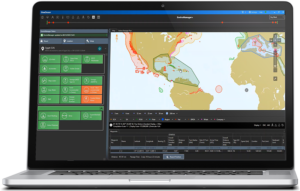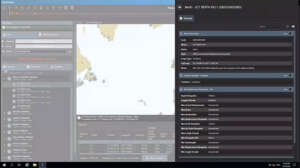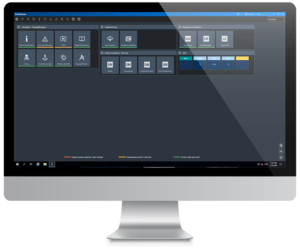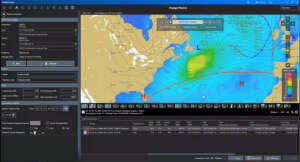
This next-generation voyage planning and environmental compliance platform is a beacon of positive progress for the shipping industry.
This next-generation voyage planning and environmental compliance platform is a beacon of positive progress for the shipping industry.
The OneOcean platform has ga[ds_preview]ined widespread industry recognition for allowing shipping companies to seamlessly plan passages, manage navigational risk and ensure widespread compliance with maritime regulations across their fleets. However, the launch of the latest version signifies that the capabilities of a digital solution, already regarded as indispensable, have taken a quantum leap forward.
“Our customers have given feedback that they value an intelligent passage planning solution, one that can take even more variables into account to generate a voyage plan that is accurate, dynamic and configured to meet the unique needs of their ship.” says Martin Taylor, CEO of OneOcean Group. “We’re confident that this solution increases compliance and will offer significant benefits to users both ashore and onboard.”

Intelligent Voyage Management
OneOcean Group now provides an intelligent voyage planning solution that automates mundane tasks, focuses users on high-priority actions and provides a digital workflow that is standardised and dynamically updated. It does this by integrating several variables such as navigational elements, voyage optimisation, and operation events such as environmental compliance into one simplified, AI-powered voyage planner. The ultimate goal is to reduce workload and enable intelligent decision-making across users and stakeholders. The end result is that users make smarter use of data so that voyage planning can be carried out more efficiently and effectively.
The company concentrated on four aspects that are key to how they will continue to evolve the software and services for customers and partners, as well as to help drive the industry forward in setting the new standard for maritime voyage management.
- Visually integrate data for better decision-making
- Structure processes and data through a fully digital workflow
- Enhance decision-making through Artificial Intelligence
- Reduce risk through customisation
1) Visually integrate data for better decision-making
The first aspect is guided by the principle that, if done well, utilising more data leads to more informed decisions. With this release, OneOcean Group leverages all the data it has gathered to power an intuitive, AI-based voyage planning solution.
As a result, users can visualise unique data sets in context to each other and see how decisions made in the planning process impact other areas. Mariners can better see the large-scale impacts of decisions and flag potential problems before they affect interconnected processes.
Most extensive environmental and port database
At any given moment, depending on several factors such as the flag state, ship class and location of the vessel, ships need to abide by a complex matrix of regulations, governed and enforced by various bodies. To make matters more complicated, these regulations are constantly updated and need to be respected as navigational activities are planned. It’s a challenge for mariners to ensure they are always aware of and complying with the most recent information as they plan the events that will take place along their sailing route.
This is especially true for environmental regulations, which are becoming more frequent
worldwide and increasingly stringent. Unlike MARPOL regulations, there is no international regulatory body that maintains a database of regional and port environmental data, making it extremely difficult for seafarers to feel confident that their vessels are abiding by all regulations as they travel from one port to another.

“We thought about how we could empower mariners and others in the industry with this information. By sourcing and collating regulations for our customers, we’ve been able to offer them peace of mind by clearly presenting what regulations are in force in different regions and linking to the source information” says James Law, Product Manager.
Over the past 12 months, the company has significantly broadened its software development capabilities while also increasing the size of its data sourcing team, who focus on bringing together data to create the most extensive navigational and environmental database.
New functionality allows environmental and regulatory standards to be displayed across super imposed layers that include regulations governed at local, regional national and international levels. All of the regulations, some of them obscure but nonetheless essential, can be visualised along the route. This allows them to incorporate compliance activities into their voyage plan. They can also reference the regulations directly in the Regs4ships software, where they can use intelligent search functionality to search across an array of topics and sources.
The platform now also includes an enhanced database of port data, complete with images mariners can use for reference. This includes berth-specific port data that provides users with information on the facilities available at each port, as well as a ‘docking checklist’, itemising the paperwork vessel personnel will be expected to produce on site.
Intuitive User Interface
The new user interface was conceived to make OneOcean even simpler to use. All aspects of a compliant voyage plan are now visible on a single screen, so officers have no need to jump back and forth between modules to make changes to a plan.
While the platform fully adheres to ECDIS chart display standards, OneOcean has new visual cues that direct users on what actions need to be taken to maintain compliance and ensure safety of navigation. If there is an area of concern along the journey, colour coding is used to quickly differentiate if everything is ok or if something needs to be addressed.
 “We focused quite a bit on making the user interface as intuitive as possible. We knew that we were adding a lot of new functionality in, but we didn’t want to lose sight of the fact that the solutionstill needs be straightforward to use. The last thing we wanted was to overcomplicate a solution that is intended to provide simplicity.” said Tony Brown, OneOcean Group’s Global Head of Products. “We found that we were able to maintain simplicity in two ways. First, we consolidated functionality from across our platform and arranged them in grouped workflows, and second, we offered users different viewing modes depending on what they are trying to achieve.”
“We focused quite a bit on making the user interface as intuitive as possible. We knew that we were adding a lot of new functionality in, but we didn’t want to lose sight of the fact that the solutionstill needs be straightforward to use. The last thing we wanted was to overcomplicate a solution that is intended to provide simplicity.” said Tony Brown, OneOcean Group’s Global Head of Products. “We found that we were able to maintain simplicity in two ways. First, we consolidated functionality from across our platform and arranged them in grouped workflows, and second, we offered users different viewing modes depending on what they are trying to achieve.”
To not overwhelm users with too much information, attention was made to clean up the UI to only show task and workflow specific data. The simple interface ensures an intuitive solution that enables easy familiarisation and reduces the training required. For example, during the planning stage, navigators need to access multiple information sources in order to understand their impact on the route. While navigating, however, the focus is more on the chart elements and events ahead. For the same reason, three viewing modes were created: Standard, Planning and Live Mode. These views each show different levels of detail depending on what the user is trying to do.
2) Control processes and structure data through fully digital workflows
The second central aspect of OneOcean is the task of accelerating decision-making by facilitating the creation and execution of automated workflows. Through this initiative, staff aboard have the time they need to focus on the vessel‘s operations instead of frittering away valuable time processing paperwork and duplicating efforts because various software tools are disconnected.
Complex paper-based and manual processes have traditionally caused confusion, conflicting information and consequent problems. The reality is, that within the maritime industry, there are so many factors at play that determine the performance and safety of a ship, its crew and the welfare of its cargo. A lot of processes need to come together and there is a huge need for cohesion.
“It‘s hard for mariners, both ashore and aboard to work cohesively when they are relying on disparate processes and looking at different data.” says Captain Malcolm Soares, Vice President of Maritime Strategy. “There is tremendous value in assuring that everyone is looking at the same, most up to date information and that processes can be regimented and easily tracked.”
With that in mind, a standardised digital workflow solves this by ensuring everyone is working the same way.
End-to-end Voyage Planning
Through the single-view concept, decision makers can collaborate and see all sections of a voyage plan, allowing them to quickly understand risks and operations of the upcoming voyage. By unifying workflows, OneOcean can now enable full, end-to-end passage planning, incorporating route generation, safety checks, optimisations and scenario evaluation. Mariners can decide to use its content entirely or in part should they choose to append portions of their official company specific passage plan and perform their approval.
Waypoint expansion and clarity in one timeline
Traditionally, operational events were added to the navigation waypoints sheets to list activities in a chronological timeline. OneOcean Group introduces the concept of a waypoints table specifically for operational events as a way to separate these two blocks of activities. All events are then integrated into one timeline that are clearly distinguished using colour coding to show navigation and operation event waypoints.
“Event-based waypoints are helpful for everyone, both on the commercial and technical side of the maritime industry. So much of how the industry operates is based on dates and times. These timelines form the basis of commercial calculations that are used to power future decision-making and identify areas of improvement.” says Tony Brown, Global Head of Products.
Event waypoints can easily be added into the event route, providing users with a complete, holistic, single-screen view of the entire planning and voyage management process. This new functionality allows mariners to stay on top of all of the operational actions that need to occur in order for ships to hit their targets and maintain all aspects of safety and compliance. As these waypoints are readily customisable, operators can include as much information as they like. Even though they are separate, they are still managed in the software as interdependent parts, meaning if changes are made to one block, the other table will be updated automatically.
3) Artificial Intelligence
Dynamic capability
A critical feature of OneOcean is that is has been designed to work dynamically. As navigation officers plan voyages, the system will notify them if changes to one factor should affect other elements of the voyage plan and suggest a course of action to rectify the problem. This allows mariners to evaluate the impact of what would change and approve any suggested updates or alternatives that are recommended at each step.
As an example, users do not have to manually search and reconfigure each element revision in the passage plan in the event of a change in circumstances such as a delay in the departure time. Merely adjusting the start time updates the entire route, plan and schedules.
Additionally, as the vessel receives regular data updates such as charts, weather and regulations, the ‘Update Review’ functions shows users the impact of this new information. If, say, a voyage had been planned three weeks before the departure date, the charts could have changed significantly in that short time. If users turn on ‘Update Review’ and select the time frame between planning and departure, zooming into each element reveals any revisions that have occurred.
“For many of our users, this new functionality will be a game changer. There are so many interdependent factors to take into account when planning a voyage, being able to set a range of criteria, enter and pull in the information in way that enables the user to visualise how they interact is extremely useful and will save a lot of time and effort” says Tony Brown, Global Head of Products.
Optimisation built-in for all scenarios
OneOcean allows route recommendations during the voyage based on factors such as navigational safety, weather forecasts, operational events and fuel performance parameters. The algorithms combine the various data sets in order to recommend an optimal route. This part of the software has been completely redesigned to integrate seamlessly with other voyage plan elements.
 Additionally, users can set ship-specific safety thresholds for variables such as wave heights and wind speeds. In turning the weather layer on, they may see that the default route would take them through an area with high wind and waves and choose to adjust accordingly. These thresholds can be used to determine weather risks both during the voyage and in the planning process, where users can see weather predictions and evaluate how they will impact the vessel.
Additionally, users can set ship-specific safety thresholds for variables such as wave heights and wind speeds. In turning the weather layer on, they may see that the default route would take them through an area with high wind and waves and choose to adjust accordingly. These thresholds can be used to determine weather risks both during the voyage and in the planning process, where users can see weather predictions and evaluate how they will impact the vessel.
Furthermore, turning on an additional layer such as EnviroManager might reveal that the default route also takes the vessel through zones that are prohibited, or require additional maneuvering. These zones could impact operation procedures or require vessels to slow down. One common example is whale migration areas, where the location and restrictions vary seasonally.
4. Customisation
As the number of automated calculations has increased, it quickly became apparent that customisation of each vessel’s voyage parameters would lead to more precise recommendations. Within the voyage plan workflow, users can enter information about their vessel, including equipment features, voyage instructions and ship characteristics in order to ensure that calculations and risk recommendations are even more accurate.
This allows mariners to plan and assess each possible route and event timeline of their voyage, while taking into account the unique characteristics of their vessel. Upon route finalisation, mariners can trigger notifications for safety measures in real time along their journey. These are seamlessly documented in digital versions of the passage plan and approval process. This functionality allows all adjustments to an intended voyage, both major and minor, to be seen almost instantly by the teams in the office ashore through the integrated web portal.
“This allows officers onboard a confident, stress-free assessment of the risk associated to their voyage and provides another means of establishing a safe navigation plan and compliance with standards.” says Captain Malcolm Soares, Vice President of Maritime Strategy.
Fleet-Wide Standardisation
For most ship managers, ensuring that ships are surpassing minimum compliance standards is important. It is difficult to ensure that both compliance and company standards are adhered to without a mechanism in place that supports users and enables enforcement.
OneOcean initially targeted three key areas where functionality has been built in to enable both external compliance and company standards to be clearly viewed in a common and understandable format. The three areas focus on navigational safety, environmental compliance and weather risk. For example, company-wide UKC calculation thresholds can be pre-defined at the fleet level, published to the vessels and then become the default setting for each ship. When combined with the ability to personalise voyage parameters, the result is a stringent navigational risk mitigation.
As many companies use a combination of digital and paper-based documentation, referencing these sources at the same time can be cumbersome and as they are formatted differently, it is harder to compare and comprehend how one relates to another. OneOcean allows users to set parameters according to their company standards. For example, the configuration of waypoints table can be set for an entire fleet, ensuring consistency in how data is displayed to users both onshore and aboard the vessel. This reduces the time needed to train crews who work on many vessels, who now don’t need to familiarize themselves with different systems on every vessel.
Customers Love It
Throughout the development, OneOcean collaborated with customers to create a solution that enables quick, informed decision-making, utilising smarter, interconnected processes to provide greater levels of standardisation across fleets.
„The passage plan creation process is far simpler now that everything is in one screen,” says Dan Pearson, 2/0 Sand Fulmar. “Making adjustments to the route and then being able to regenerate the passage plan immediately is a massive time-saver for us.”
The feedback has been overwhelmingly positive. Beta trials have been very successful and users emphasise the value that has been realised using the new version.
The new environmental database, that can be configured fleet side for entire fleets, has been extremely valuable. Intership Navigation, one of the early adopters of environmental solutions said while trialing the new release of OneOcean, that they were pleased with the added functionality. “The new waste streams and new equipment settings make EnviroManager+ so much better for the crew,” adds Captain Piotr Rusinek, Intership Navigation. “It is much quicker and easier for them to understand what is allowed and prohibited.”
The approach to this new version, using defined focal areas and customer partnerships to aid development has laid strong foundations for the continued evolution of the OneOcean portfolio. This works in line with the company mission to deliver maritime solutions that remove the boundaries between ship and shore, helping customers benefit from more efficient, cleaner and safer practices.
The latest version of the product launched 1 February 2021, to find out more about OneOcean Group and the solutions available get in touch via our website oneocean.com.
















